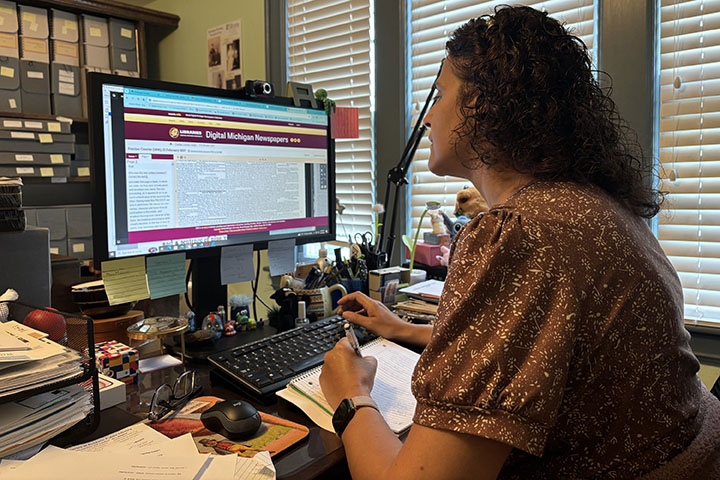Clarke project breathes digital life into newspapers
Researchers learn about Underground Railroad through collection

A volunteer researcher with a museum in suburban Detroit found a trail of microfilm breadcrumbs that led staff to Clarke Historical Library’s digitized newspaper collection and a major countywide project about the Underground Railroad.
The volunteer was following a tip that a Revolutionary War veteran was buried in Birmingham when he found clues about former slaves. Following up in the Birmingham Eccentric, preserved on microfilm, would require long work hours.
Donna Casaceli, the Birmingham Museum’s museum specialist and archivist, had a better idea. She’d met staff from Central Michigan University’s Clarke Historical Library at a conference a few years back and knew about their project making digitized copies of Michigan newspapers available for free.
She checked out the Clarke’s online collection of digitized newspapers.
“It was a gold mine,” Casaceli said.
Microfilm remains the standard way to preserve newspapers, but digitizing them provides better access, said Carrie Marsh, director of Clarke Historical Library.
Microfilm requires a visit to where it is physically held, but digitization makes possible access through the Internet. Clarke Historical Library’s digital collection comes complete with a keyword search feature.
Clarke Historical Library staff recently announced that they have uploaded more than 1 million newspaper pages to its website DigMichNews.com.

When you add digitized pages for a Library of Congress collection, it’s closer to 1.2 million available to the public, said Bryan Whitledge, public services librarian with Clarke Historical Library. Altogether, Clarke Historical Library has digitized nearly 2 million pages.
As of August 2016, the library offered 240,000 digitized pages.
Those represent newspapers – many of them small and with short publication lives – across the state of Michigan, including many from Michigan’s mid-to-northern Lower Peninsula, he said.
Several Oakland County newspapers provided Casaceli with insights into the Underground Railroad’s history in that area. Clarke Historical Library’s digital collection includes newspapers that were both pro-abolition and pro-slavery in their outlooks. The papers carried on a lively debate on their pages, Casaceli said.
That is the strength of what the Clarke is doing, Whitledge said. Small, community papers that might otherwise have yellowed and decayed into dust have a new life online where people can read them. Their work preserves that history for researchers.
Their online collection also includes a range of newspaper publishing runs. They have the sole known issue of the Breckenridge Clarion from Sept. 17, 1908. They also have more than a century of the Clare Sentinel, from 1896-1999.
Those small papers provide greater detail into the lives of local citizens, Casaceli said. They introduce you to people who also played vital roles in a community’s early years but are forgotten.
In her community, that included a man named Elijah Fish. Elijah Staunton Fish moved to Birmingham and founded Birmingham’s First Presbyterian Church. He also sponsored abolitionist lectures and gave money to support the Underground Railroad.
They learned about people like Fish, not just from newspapers on their side, but also from stories from opponents, Casaceli said. Sometimes a report in an abolitionist paper would get a kind of confirmation by an event mentioned in a pro-slavery paper.
“The more nuggets we get, the more little pieces we get, the more we can say, ‘The story was probably correct’,” she said.
Ten years ago, finding out about Fish was a needle in a haystack work. The Clarke digitized Pontiac’s newspapers and Elijah Fish was given new life via keyword search.
“We would have never known about Elijah Fish,” Casaceli said.
Casaceli has knit together the narrative of the Underground Railroad in Oakland County from different accounts published in various newspapers across the decades that it was active.
It’s an expansion that started with a volunteer’s random discovery and was made possible by the Clarke’s digitized newspaper collection. It now involves libraries and historical societies across Oakland County.
“What started off as a newspaper project led to a huge countywide project,” Casaceli said.
There's a website that introduces many of the people she found through her research, and they are working with curriculum specialists to incorporate what they’ve learned into how local history is taught to students across the county, she said.
Digitization provides a critical tool for historical research, Whitledge said. It’s vital to preserve them as microfilm so the public record created by old newspapers isn’t lost if something happens to the remaining old copies.
There is considerable demand for services like Clarke Historical Library’s digitized newspaper collection. Since 2016, the website has generated more than 8 million hits, with 2.4 million just between July 2022 and June 2023.
“It’s a snowball that keeps growing,” Whitledge said.




